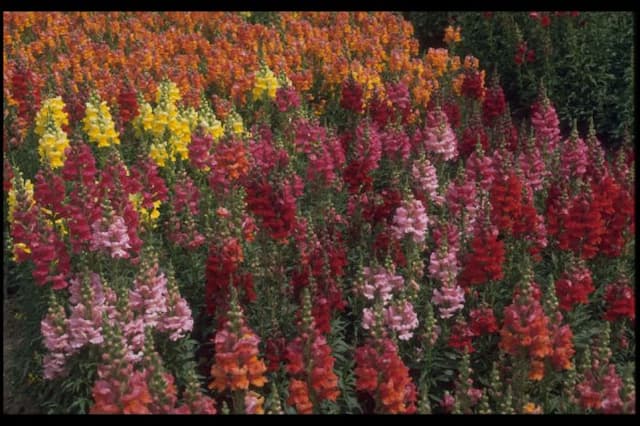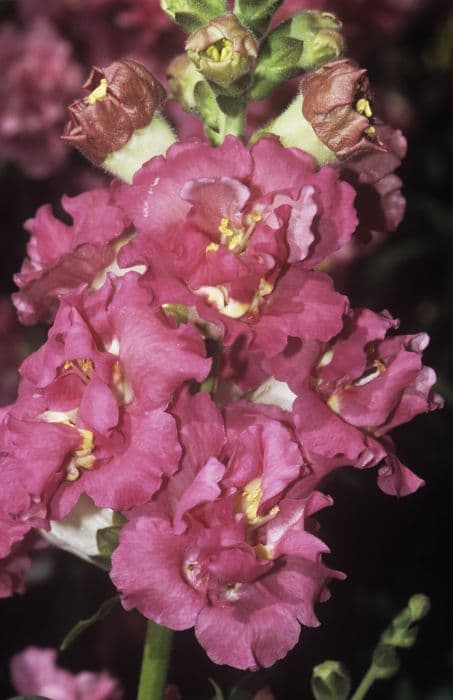Beardtongue Penstemon 'Flame'

ABOUT
Penstemon 'Flame', often referred to as Beardtongue, is a striking perennial that is well-loved for its showy blooms and vibrant colors. It generally displays a clumping growth habit with a robust and upright demeanor. The foliage consists of lance-shaped leaves that are dark green in color, providing a lush backdrop to the flowers. The standout feature of this Beardtongue variant is its flowers. The blooms are tubular and come in vivacious shades of red, pink, or sometimes a reddish-pink, suggesting a flaming appearance which is reflected in its cultivar name 'Flame'. These flowers are neatly arranged on tall spires that rise above the foliage, creating a dramatic and eye-catching display. Attracting pollinators such as bees, hummingbirds, and butterflies, the plant becomes a lively hub in the garden. The flowers have a two-lipped look: the upper lip is usually less prominent, while the lower lip is more flared and often shows a lighter color or even a white throat, adding contrast and depth to the flower's appearance. After the flowering period, the Beardtongue may produce small capsules containing seeds, which can sometimes add a further decorative element to the plant. This Penstemon cultivar maintains its appealing form throughout the growing season with its attractive foliage and prolonged flowering period, making it a popular choice for adding a splash of color to gardens and landscapes.
About this plant
 Names
NamesFamily
Plantaginaceae
Synonyms
Beard Tongue, Beardtongue
Common names
Penstemon 'Flame'
 Toxicity
ToxicityTo humans
Penstemon 'Flame', commonly known as Beardtongue, is not known to be toxic to humans. Generally, this plant is considered safe and does not produce toxic effects if ingested. However, it is always advisable to avoid consuming plants not intended for human consumption as individual reactions can vary.
To pets
Beardtongue is not typically listed as a toxic plant to pets, which means that it usually does not pose a significant risk of toxicity to dogs, cats, and other domestic animals. It is not known to cause any specific symptoms of poisoning in pets. However, ingestion of plant material can sometimes lead to gastrointestinal upset in animals, so it is still wise to prevent pets from ingesting plants that are not part of their normal diet.
 Characteristics
CharacteristicsLife cycle
Perennials
Foliage type
Deciduous
Color of leaves
Green
Flower color
Red
Height
2-3 feet (0.6-0.9 meters)
Spread
1-2 feet (0.3-0.6 meters)
Plant type
Herbaceous
Hardiness zones
4-9
Native area
North America
Benefits
 General Benefits
General Benefits- Attracts pollinators: Penstemon 'Flame' is known for its ability to attract bees, butterflies, and other important pollinators.
- Low maintenance: This plant is drought-tolerant once established, requiring minimal watering and care.
- Long blooming period: Penstemon 'Flame' offers an extended blooming season, providing vibrant colors from late spring to early fall.
- Adaptable: It can thrive in a range of soil types, as long as there is good drainage.
- Improves biodiversity: By attracting pollinators, Penstemon 'Flame' helps support local ecosystems and wildlife.
- Landscape versatility: Suitable for borders, rock gardens, and wildflower meadows, it provides flexibility in garden design.
- Resistant to pests: Penstemon 'Flame' is generally resistant to pests and diseases, reducing the need for chemical treatments.
- Provides structure: Its upright growth habit can add vertical interest to gardens and landscapes.
- Color variety: It is available in a range of colors which can complement various garden color schemes.
 Medical Properties
Medical PropertiesThis plant is not used for medical purposes.
 Air-purifying Qualities
Air-purifying QualitiesThis plant is not specifically known for air purifying qualities.
 Other Uses
Other Uses- Plant Pressing: The vibrant flowers of the Penstemon Flame can be pressed and used in art projects such as flower pressing, creating beautiful patterns and designs for stationery, bookmarks, or wall art.
- Dye Source: The plant's flowers can be used to create natural dyes for fabrics or paper, providing a potential range of red hues depending on the mordant used.
- Photography Subject: Due to its striking appearance, the Penstemon Flame can be an excellent subject for botanical photography, helping photographers practice macro techniques and color composition.
- Habitat Enrichment: When planted in gardens, the Penstemon Flame can enhance the habitat for local wildlife, attracting pollinators such as bees and hummingbirds.
- Garden Border: Its upright growth habit makes it suitable for use as a border plant in gardens, creating visual structure and contrast against green foliage.
- Educational Tool: The plant can be used in educational settings like schools or botanical gardens to demonstrate plant growth, pollination, and the lifecycle of perennials.
- Artistic Inspiration: Artists may draw inspiration from the Penstemon Flame's form and color, using it as a reference for paintings, sculptures, or other artistic creations.
- Culinary Garnish: Although not commonly consumed, the flowers can be used as an edible garnish for salads and desserts, adding a splash of color to dishes.
- Thematic Landscaping: The Penstemon Flame can be incorporated into fire or flame-themed gardens due to its name and fiery color palette.
- Crafting: Dried flowers of the Penstemon Flame can be used in crafting, such as in wreath making or as inclusion in homemade candles for decoration.
Interesting Facts
 Feng Shui
Feng ShuiThe Beardtongue is not used in Feng Shui practice.
 Zodiac Sign Compitability
Zodiac Sign CompitabilityThe Beardtongue is not used in astrology practice.
 Plant Symbolism
Plant Symbolism- Endurance and Hardiness: The Penstemon, also known as Beardtongue, is a hardy plant that can withstand tough conditions and is often seen as a symbol of strength and the ability to persist through challenges.
- Boldness: With its bright 'Flame' coloring, Beardtongue can represent boldness and vibrancy, encouraging an individual to stand out and be expressive.
- Health and Vitality: The plant's lush growth and colorful flowers are associated with good health and vitality, symbolizing a thriving life or recovery.
- Wealth and Diversification: Beardtongue has a wide variety that reflects diversity and can symbolize the varied richness in one's life or endeavors.
- Attracting New Opportunities: The tubular flowers of Beardtongue attract hummingbirds and butterflies, which signifies the draw of new opportunities and beneficial relationships.
 Water
WaterTo ensure the Beardtongue, commonly known as Penstemon 'Flame', thrives, water it deeply once a week during active growth periods, providing about one to two gallons per plant. During the hotter and drier months, check the soil moisture regularly; it should be moist but not waterlogged. Reduce watering frequency in winter when the plant is dormant, aiming for once every two to three weeks or when the soil is dry to the touch. To avoid fungal diseases, water at the base of the plant rather than from overhead, and ensure proper drainage to prevent root rot.
 Light
LightBeardtongue prefers full sun to partial shade conditions, thriving best when it receives at least 6 to 8 hours of sunlight each day. Plant it in a location where it gets plenty of morning light and some afternoon shade, especially in regions with very hot summers. The ideal spot for Penstemon 'Flame' is an east-facing or south-facing garden area that provides adequate light without exposing the plant to the harsh afternoon sun.
 Temperature
TemperatureBeardtongue is adaptable to a range of temperatures but performs best in conditions where the average temperature is between 60°F and 85°F. It can tolerate temperatures down to about 20°F, making it suitable for many temperate climates. The ideal temperature range promotes healthy growth and abundant flowering, but it's important to protect the plant from freezing temperatures and harsh winter winds.
 Pruning
PruningPrune Beardtongue in late winter or early spring before new growth begins to remove any dead or damaged stems and to maintain the plant's shape. Pruning promotes healthy growth, encourages a bushier plant, and helps prevent diseases by increasing air circulation. Deadheading spent blooms throughout the growing season can also encourage additional flowering. The best time for pruning is when the plant is dormant, which minimizes stress and promotes vigorous spring growth.
 Cleaning
CleaningAs needed
 Soil
SoilBeardtongue prefers fertile, well-draining soil with a neutral to slightly acidic pH, around 6.0 to 7.0. A mix of loam, sand, and compost is ideal to ensure good drainage and fertility.
 Repotting
RepottingBeardtongue typically doesn't require frequent repotting and can be done every 3-4 years or when it outgrows its current pot.
 Humidity & Misting
Humidity & MistingBeardtongue tolerates a wide range of humidity levels but prefers a moderate humidity environment without requiring any special conditions.
 Suitable locations
Suitable locationsIndoor
Place in bright, indirect light and ensure the pot has drainage.
Outdoor
Plant in sunny spot with well-draining soil.
Hardiness zone
3-8 USDA
 Life cycle
Life cyclePenstemon 'Flame', commonly known as Beardtongue, begins its life cycle when seeds germinate in late spring after the last frost, requiring well-drained soil and full sun to partial shade. Seedlings emerge and establish a small rosette of leaves, gradually developing into a sturdy stem with lance-shaped foliage. During its second year, the biennial Beardtongue enters the flowering stage in late spring to early summer, producing tall spikes adorned with tubular flowers that are highly attractive to pollinators like bees and hummingbirds. After flowering, the plant sets seed, which can be dispersed by wind or animals, ensuring the continuation of the species. Beardtongue is a perennial in many climates, and as such, it will continue to grow and bloom each year, with some plants declining after a few years, at which point division or propagation may be necessary to rejuvenate the clump. In the fall, the plant will die back naturally, with the roots overwintering and regenerating the following spring to repeat the cycle.
 Propogation
PropogationPropogation time
Spring-Early Summer
Propogation: The Penstemon 'Flame', commonly known as Beardtongue, is often propagated by seeds or cuttings. The most popular method of propagation for Beardtongue is through stem cuttings, typically done in late spring to early summer. To propagate by cuttings, select a healthy, non-flowering stem and cut a 4 to 6-inch (about 10 to 15 cm) length, making sure there are several nodes present. Strip the lower leaves, dip the cut end in rooting hormone, and then insert it into a pot filled with a well-draining soil mix. Maintaining consistent moisture without waterlogging and providing indirect light will encourage rooting within a few weeks, after which the new plant can eventually be transplanted outdoors.





![Snapdragon [Pretty in Pink]](/_next/image?url=https%3A%2F%2Fplants-admin.emdemapps.com%2Fimages%2Fplants%2F%2Fimages%2F604b5cb3b5385.png&w=640&q=75)



